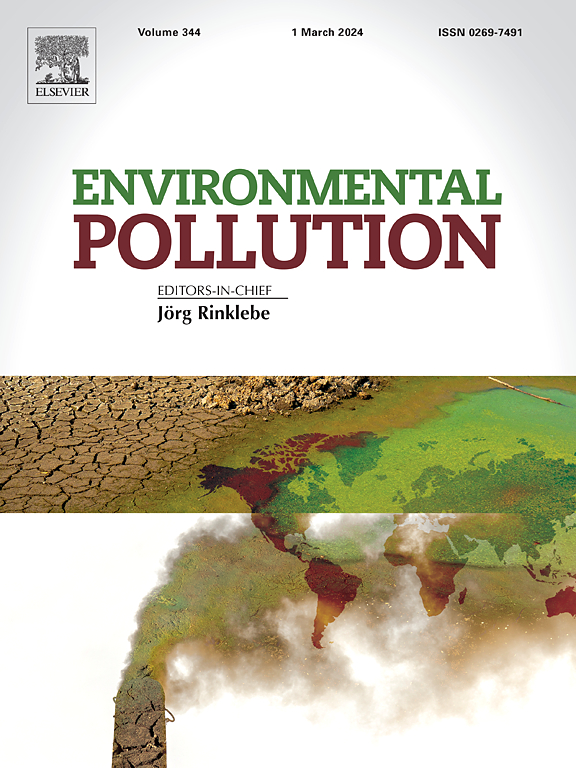Pollution profiles, pathogenicity, and toxicity of bioaerosols in the atmospheric environment of urban general hospital in China
IF 7.6
2区 环境科学与生态学
Q1 ENVIRONMENTAL SCIENCES
引用次数: 0
Abstract
Airborne microorganisms in hospitals present significant health risks to both patients and employees. However, their pollution profiles and associated hazards in different hospital areas remained largely unknown during the extensive use of masks and disinfectants. This study investigated the characteristics of bioaerosols in an urban general hospital during the COVID-19 pandemic and found that airborne bacteria and fungi concentrations range from 87 ± 35 to 1037 ± 275 CFU/m3 and 21 ± 15 to 561 ± 132 CFU/m3, respectively, with the outpatient clinic and internal medicine ward showing the highest levels. The operating room (OR) and clinical laboratory (LA) had lower bioaerosol levels but higher microbial activities, suggesting that disinfection procedures used to clean bioaerosols may change them into a viable but non-culturable state. The dominant fungi were Cladosporium, Aspergillus, and Penicillium, while the most common viruses were human associated gemykibivirus 2 and human alpha herpesvirus 1. Besides, the dominant pathogens were Staphylococcus aureus, Salmonella enterica, and Pseudomonas aeruginosa. Bacitracin and macrolides resistance genes bacA and ermC were the most prevalent subtypes of antibiotic resistance genes. Compared to the control sample, hospital-acquired bioaerosols, particularly from the outpatient examination room and emergency room can trigger higher levels of inflammatory factors and cell toxicity but lower cell proliferation rates. Lower cell toxicity was observed in low-risk areas (intensive care unit, LA, and OR). This study provides a new method for assessing bioaerosol health risks and enhances understanding of nosocomial and opportunistic infections and their control.


中国城市综合医院大气环境中生物气溶胶的污染特征、致病性和毒性
医院中空气传播的微生物对病人和员工都有重大的健康风险。然而,在广泛使用口罩和消毒剂期间,它们在不同医院区域的污染概况和相关危害在很大程度上仍然未知。本研究调查了某城市综合医院2019冠状病毒病疫情期间空气中生物气溶胶的特征,发现空气中细菌和真菌的浓度分别为87±35 ~ 1037±275 CFU/m3和21±15 ~ 561±132 CFU/m3,其中门诊和内科病房的浓度最高。手术室(OR)和临床实验室(LA)的生物气溶胶水平较低,但微生物活性较高,这表明用于清洁生物气溶胶的消毒程序可能使其变为可存活但不可培养的状态。主要真菌为枝孢菌、曲霉菌和青霉,最常见的病毒为人源性双基比病毒2型和人源性疱疹病毒1型。优势病原菌为金黄色葡萄球菌、肠炎沙门氏菌和铜绿假单胞菌。杆菌肽和大环内酯类耐药基因bacA和ermC是最常见的抗生素耐药基因亚型。与对照样本相比,医院获得的生物气溶胶,特别是来自门诊检查室和急诊室的生物气溶胶可引发更高水平的炎症因子和细胞毒性,但细胞增殖率较低。在低风险区域(重症监护病房、LA和OR)观察到较低的细胞毒性。本研究为生物气溶胶健康风险评估提供了新的方法,并提高了对医院感染和机会性感染及其控制的认识。
本文章由计算机程序翻译,如有差异,请以英文原文为准。
求助全文
约1分钟内获得全文
求助全文
来源期刊

Environmental Pollution
环境科学-环境科学
CiteScore
16.00
自引率
6.70%
发文量
2082
审稿时长
2.9 months
期刊介绍:
Environmental Pollution is an international peer-reviewed journal that publishes high-quality research papers and review articles covering all aspects of environmental pollution and its impacts on ecosystems and human health.
Subject areas include, but are not limited to:
• Sources and occurrences of pollutants that are clearly defined and measured in environmental compartments, food and food-related items, and human bodies;
• Interlinks between contaminant exposure and biological, ecological, and human health effects, including those of climate change;
• Contaminants of emerging concerns (including but not limited to antibiotic resistant microorganisms or genes, microplastics/nanoplastics, electronic wastes, light, and noise) and/or their biological, ecological, or human health effects;
• Laboratory and field studies on the remediation/mitigation of environmental pollution via new techniques and with clear links to biological, ecological, or human health effects;
• Modeling of pollution processes, patterns, or trends that is of clear environmental and/or human health interest;
• New techniques that measure and examine environmental occurrences, transport, behavior, and effects of pollutants within the environment or the laboratory, provided that they can be clearly used to address problems within regional or global environmental compartments.
 求助内容:
求助内容: 应助结果提醒方式:
应助结果提醒方式:


